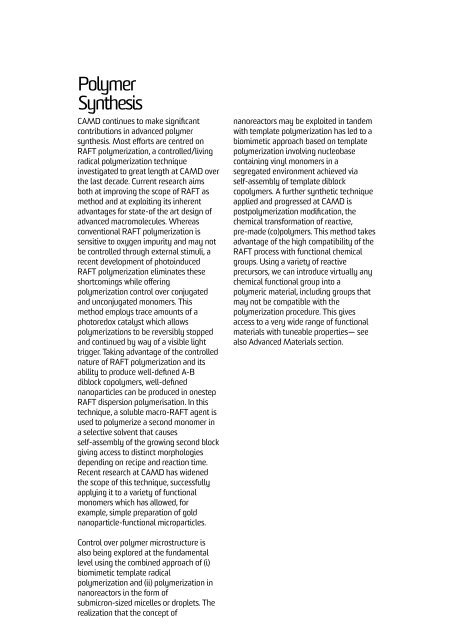CAMD_2015_Annual_Report
Create successful ePaper yourself
Turn your PDF publications into a flip-book with our unique Google optimized e-Paper software.
Polymer<br />
Synthesis<br />
<strong>CAMD</strong> continues to make significant<br />
contributions in advanced polymer<br />
synthesis. Most efforts are centred on<br />
RAFT polymerization, a controlled/living<br />
radical polymerization technique<br />
investigated to great length at <strong>CAMD</strong> over<br />
the last decade. Current research aims<br />
both at improving the scope of RAFT as<br />
method and at exploiting its inherent<br />
advantages for state-of the art design of<br />
advanced macromolecules. Whereas<br />
conventional RAFT polymerization is<br />
sensitive to oxygen impurity and may not<br />
be controlled through external stimuli, a<br />
recent development of photoinduced<br />
RAFT polymerization eliminates these<br />
shortcomings while offering<br />
polymerization control over conjugated<br />
and unconjugated monomers. This<br />
method employs trace amounts of a<br />
photoredox catalyst which allows<br />
polymerizations to be reversibly stopped<br />
and continued by way of a visible light<br />
trigger. Taking advantage of the controlled<br />
nature of RAFT polymerization and its<br />
ability to produce well-defined A-B<br />
diblock copolymers, well-defined<br />
nanoparticles can be produced in onestep<br />
RAFT dispersion polymerisation. In this<br />
technique, a soluble macro-RAFT agent is<br />
used to polymerize a second monomer in<br />
a selective solvent that causes<br />
self-assembly of the growing second block<br />
giving access to distinct morphologies<br />
depending on recipe and reaction time.<br />
Recent research at <strong>CAMD</strong> has widened<br />
the scope of this technique, successfully<br />
applying it to a variety of functional<br />
monomers which has allowed, for<br />
example, simple preparation of gold<br />
nanoparticle-functional microparticles.<br />
nanoreactors may be exploited in tandem<br />
with template polymerization has led to a<br />
biomimetic approach based on template<br />
polymerization involving nucleobase<br />
containing vinyl monomers in a<br />
segregated environment achieved via<br />
self-assembly of template diblock<br />
copolymers. A further synthetic technique<br />
applied and progressed at <strong>CAMD</strong> is<br />
postpolymerization modification, the<br />
chemical transformation of reactive,<br />
pre-made (co)polymers. This method takes<br />
advantage of the high compatibility of the<br />
RAFT process with functional chemical<br />
groups. Using a variety of reactive<br />
precursors, we can introduce virtually any<br />
chemical functional group into a<br />
polymeric material, including groups that<br />
may not be compatible with the<br />
polymerization procedure. This gives<br />
access to a very wide range of functional<br />
materials with tuneable properties— see<br />
also Advanced Materials section.<br />
Control over polymer microstructure is<br />
also being explored at the fundamental<br />
level using the combined approach of (i)<br />
biomimetic template radical<br />
polymerization and (ii) polymerization in<br />
nanoreactors in the form of<br />
submicron-sized micelles or droplets. The<br />
realization that the concept of


